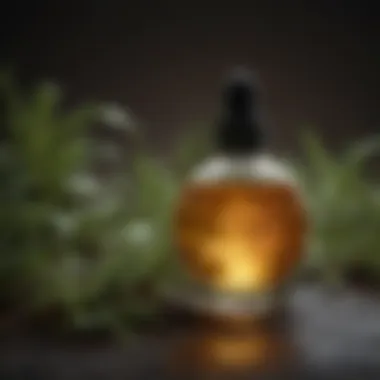Natural Hair Bumps Treatment at Home: Effective Remedies Revealed


Trend Report
Style Guides
In the realm of remedial approaches for hair bumps, incorporating key styling tips can enhance the overall effectiveness of the treatments. These styling tips go beyond just fashion choices and delve into how one presents their skin health routine. By considering body shape guides and wardrobe essentials, individuals can complement their efforts in treating hair bumps with choices that align with their unique style and preferences. Understanding how to accentuate one's best features and care for skin health can make a significant impact on the results obtained from home remedies.
Beauty Tips & Hacks
Embarking on a journey to tackle hair bumps through home remedies provides an opportunity to explore various beauty tips and hacks. These insights encompass not only makeup techniques but also delve into skincare routines tailored to different skin types and concerns. By incorporating DIY beauty hacks into the mix, individuals can elevate their skincare routine and address hair bumps with a personalized approach. These practical tips and hacks can revolutionize the effectiveness of home remedies, ensuring a comprehensive and tailored solution to this common skin issue.
Product Reviews
In the realm of home remedies for hair bumps, understanding the significance of different products becomes crucial. Fashion reviews that highlight clothing brands using skin-friendly materials and beauty product reviews showcasing natural skincare lines can assist individuals in making informed choices. By sharing tried and tested experiences with popular beauty and fashion products, individuals can navigate the market with confidence, choosing items that align with their skin health goals and preferences.
Celebrity Fashion & Beauty
Exploring celebrity-inspired skincare routines and fashion choices can offer valuable insights for individuals seeking effective home remedies for hair bumps. By studying red carpet looks and analyzing the style evolution of celebrities known for their radiant skin, readers can glean insider beauty secrets that enhance their own skincare regimen. Recreating celebrity red carpet outfits and makeup looks can inspire individuals to approach their skin health with a renewed sense of style and sophistication.
Understanding Hair Bumps
Hair bumps can be a common concern for many individuals, causing discomfort and affecting skin health. Understanding the root causes of hair bumps is crucial in developing effective treatment strategies. By exploring the reasons behind hair bumps, we can implement targeted remedies to alleviate symptoms and prevent recurrence. This article delves into the causes of hair bumps, shedding light on ingrown hairs, friction or irritation, and clogged hair follicles.
Causes of Hair Bumps
Ingrown Hairs
Ingrown hairs are a significant factor contributing to the development of hair bumps. Typically occurring after hair removal, ingrown hairs result from hair curling back into the skin instead of growing outward. This abnormal hair growth leads to inflammation and the formation of painful bumps. Understanding the nature of ingrown hairs is essential for addressing this specific cause effectively. While ingrown hairs are a common issue, proper exfoliation and skincare techniques can help prevent their occurrence.
Friction or Irritation
Friction and irritation also play a role in the formation of hair bumps. Constant rubbing or chafing of the skin can cause irritation, leading to redness, bumps, and discomfort. Clothing, accessories, or activities that create friction against the skin can exacerbate this condition. Identifying sources of friction and reducing contact can help alleviate symptoms and promote healing. By addressing this aspect, individuals can experience relief from hair bumps and prevent further skin irritation.
Clogged Hair Follicles
Clogged hair follicles contribute significantly to the development of hair bumps. When sebum, dirt, or dead skin cells block the hair follicles, it creates an ideal environment for bacterial growth and inflammation. This blockage can manifest as raised bumps or pustules on the skin, causing pain and discomfort. Clearing clogged hair follicles through exfoliation and proper cleansing is crucial for preventing and treating hair bumps effectively. By understanding the role of clogged follicles, individuals can implement targeted skincare routines to promote clear and healthy skin.
Types of Hair Bumps
Razor Bumps


Razor bumps, also known as pseudofolliculitis barbae, are a common issue for individuals who shave regularly. These bumps occur when hair curls back into the skin after shaving, resulting in inflammation and redness. Razor bumps can be painful and unsightly, affecting both men and women who engage in shaving practices. Understanding the triggers of razor bumps and adopting proper shaving techniques can help reduce their occurrence and promote smoother skin.
Folliculitis
Folliculitis is another type of hair bump caused by the inflammation of hair follicles. It can result from bacterial or fungal infections, leading to the formation of red, pus-filled bumps on the skin. Folliculitis can be itchy and uncomfortable, affecting individuals with compromised skin barriers or those exposed to unhygienic conditions. Treating folliculitis involves addressing the underlying infection and promoting skin healing through topical remedies and proper skincare practices.
Pseudofolliculitis Barbae
Pseudofolliculitis barbae refers to chronic ingrown hairs that occur due to curly hair growth patterns. Common in individuals with tightly curled hair, pseudofolliculitis barbae results in painful bumps and scarring. Managing this condition involves gentle exfoliation, moisturization, and skincare routines tailored to prevent ingrown hairs. By recognizing the characteristics of pseudofolliculitis barbae, individuals can take proactive steps to maintain healthy skin and alleviate discomfort.
When it comes to addressing hair bumps, turning to effective home remedies can offer a natural and accessible solution to improve skin health. In this section, we will delve into various remedies that not only target the core of the issue but also provide practical and affordable alternatives to conventional treatments.
Gentle Exfoliation
Exfoliation plays a crucial role in preventing and treating hair bumps by sloughing off dead skin cells and unclogging pores. Let us explore the significance of gentle exfoliation methods in combating this common concern.
Sugar Scrub
Sugar scrub is a popular exfoliant known for its gentle yet effective abrasive texture, making it ideal for delicate skin prone to irritation. Its granules help remove dead skin cells without being too harsh, promoting smoother skin texture. Despite its benefits, it is essential to moderate its use to prevent over-exfoliation, which can damage the skin barrier.
Oatmeal Scrub
Oatmeal scrub is a soothing exfoliator that not only buffs away impurities but also calms inflamed skin. Its natural anti-inflammatory properties make it a suitable option for those with sensitive skin or existing irritation. However, individuals with gluten allergies should opt for gluten-free oatmeal variants to avoid adverse reactions.
Baking Soda Paste
Baking soda paste is revered for its exfoliating and antibacterial properties, making it effective in combating hair bumps and preventing infections. Its alkaline nature helps balance skin p H levels, reducing inflammation and redness. Nonetheless, individuals with sensitive skin should perform a patch test as baking soda can cause irritation in some cases.
Anti-Inflammatory Remedies
Inflammation is a key component of hair bumps, making anti-inflammatory remedies a valuable addition to your skincare routine. Discover the benefits of incorporating these soothing ingredients into your treatment plan.
Aloe Vera Gel
Aloe vera gel is renowned for its healing properties, providing a cooling sensation that alleviates discomfort associated with hair bumps. Its moisturizing effect helps hydrate the skin, promoting faster healing of irritated areas. While aloe vera is well-tolerated by most skin types, individuals with latex allergies should opt for latex-free products.
Tea Tree Oil
Tea tree oil boasts powerful antibacterial and anti-inflammatory qualities, making it an excellent remedy for combating infections and reducing redness. Its potent nature requires dilution before direct application to prevent skin irritation. Additionally, patch testing is recommended to ensure skin compatibility.


Witch Hazel
Witch hazel is a natural astringent known for its ability to tighten skin and reduce inflammation, making it beneficial for soothing hair bumps. Its antiseptic properties help cleanse the skin, preventing further breakouts. However, prolonged use may lead to dryness, so it is advisable to follow up with a hydrating moisturizer.
Soothing Moisturizers
Moisturizing is essential in maintaining skin health, especially when dealing with hair bumps. Explore the calming properties of these moisturizers and their role in nourishing your skin.
Coconut Oil
Coconut oil is a popular emollient that hydrates the skin, forming a protective barrier to prevent moisture loss. Its antimicrobial properties can help combat bacteria, reducing the risk of infections in inflamed areas. Despite its benefits, individuals with oily skin should use it sparingly to avoid clogging pores.
Shea Butter
Shea butter is a rich moisturizer that soothes dry, irritated skin while providing a dose of essential nutrients. Its anti-inflammatory properties can help reduce redness and itchiness associated with hair bumps. However, those with tree nut allergies should opt for alternatives to prevent adverse reactions.
Honey
Honey is a natural humectant that draws moisture to the skin, promoting hydration and healing. Its antimicrobial properties can help prevent infections while soothing irritated areas. It is important to choose raw, unprocessed honey for maximum benefits, as processed variants may lack the same therapeutic properties.
Herbal Treatments
Herbal remedies offer a holistic approach to tackling hair bumps, harnessing the power of nature's healing ingredients. Discover the unique characteristics of these herbal treatments and their benefits for skin health.
Calendula
Calendula is hailed for its anti-inflammatory and antibacterial properties, making it a potent remedy for soothing irritated skin. Its gentle nature suits all skin types, making it a versatile option for addressing various skin concerns. Regular use of calendula can help improve skin tone and texture over time.
Chamomile
Chamomile possesses calming properties that reduce redness and irritation in inflamed areas, aiding in the healing process. Its antioxidant-rich composition helps protect the skin from environmental stressors, promoting overall skin health. Individuals with ragweed allergies should perform a patch test before using chamomile-based products.
Green Tea
Green tea is packed with antioxidants that combat free radicals, promoting skin rejuvenation and repair. Its anti-inflammatory properties help reduce swelling and redness caused by hair bumps, encouraging faster recovery. Regular green tea application can boost skin resilience and vitality, enhancing your skin's natural radiance.
Preventive Measures
In the realm of hair bump treatment, preventive measures hold a paramount significance. These measures serve as proactive ways to tackle the issue even before it arises, significantly reducing the chances of developing hair bumps. By focusing on preventive measures, individuals can establish a consistent routine that promotes healthy skin and wards off potential skin concerns. Preventive measures encompass various elements such as maintaining proper hygiene, implementing effective hair care practices, and adopting healthy lifestyle habits. Each of these components plays a crucial role in ensuring skin health and preventing the occurrence of unsightly hair bumps.


Maintaining Proper Hygiene
Regular Cleansing:
Regular cleansing stands out as a foundational aspect of maintaining proper hygiene in the context of preventing hair bumps. This practice involves the routine washing of the skin to eliminate dirt, excess oils, and other impurities that can clog pores and lead to skin issues like ingrown hairs. Regular cleansing helps in keeping the skin clean, clear, and free from obstructions that contribute to hair bumps. Its gentle yet effective nature makes it a popular choice for individuals seeking to maintain optimal skin health. However, individuals should be aware of potential over-cleansing, which can strip the skin of its natural oils, leading to dryness and irritation. Striking a balance in cleansing frequency is essential to reaping the benefits of regular cleansing without causing harm to the skin.
Avoiding Tight Clothing:
Another essential aspect of maintaining proper hygiene to prevent hair bumps is avoiding tight clothing. Tight clothing can create friction against the skin, leading to inflammation and irritation, which can exacerbate existing skin conditions like razor bumps or folliculitis. By opting for loose-fitting clothing, individuals can reduce the likelihood of skin irritation and allow the skin to breathe freely. This choice promotes skin health by minimizing unnecessary pressure on hair follicles and reducing the risk of developing painful and unsightly bumps. Avoiding tight clothing is a simple yet impactful preventive measure that can significantly contribute to overall skin wellness.
Hair Care Practices
Proper Shaving Techniques:
Effective hair care practices play a crucial role in preventing hair bumps, with proper shaving techniques being a cornerstone of this approach. By adopting appropriate shaving methods such as using a sharp razor, following the direction of hair growth, and avoiding repetitive strokes over the same area, individuals can reduce the chances of developing ingrown hairs and razor bumps. Proper shaving techniques aim to minimize skin irritation and inflammation, resulting in smoother and healthier skin post-shave. The emphasis on technique over speed or force underscores the importance of gentle and precise shaving for optimal skin care.
Moisturizing After Shaving:
After shaving, moisturizing the skin is an indispensable step in promoting skin health and preventing hair bumps. Moisturizing helps to replenish lost moisture, soothe the skin, and create a protective barrier that reduces friction and irritation. Choosing a hydrating moisturizer tailored to individual skin needs can further enhance the benefits of this practice. Moisturizing after shaving is especially beneficial for individuals with sensitive skin or a tendency to develop razor bumps, as it can help maintain skin integrity and minimize the risk of post-shave complications.
Healthy Lifestyle Habits
Balanced Diet:
The pursuit of a balanced diet is not only essential for overall health but also plays a significant role in skin wellness and hair bump prevention. A diet rich in vitamins, minerals, and antioxidants can support skin regeneration, repair, and resilience, minimizing the impact of external stressors on skin health. Including foods that nourish the skin, such as fruits, vegetables, lean proteins, and healthy fats, can fortify the skin barrier and enhance its ability to combat skin issues like hair bumps. The holistic benefits of a balanced diet extend beyond aesthetic concerns, contributing to overall well-being and vitality.
Adequate Water Intake:
Hydration is key to maintaining skin health and preventing hair bumps, making adequate water intake a vital component of a healthy lifestyle. Water plays a crucial role in skin hydration, toxin elimination, and nutrient transportation, all of which are essential for optimal skin function. By staying properly hydrated, individuals can support skin elasticity, suppleness, and resilience, reducing the likelihood of skin dryness, irritation, and inflammation. Adequate water intake complements other preventive measures, amplifying their efficacy and forming a holistic approach to skin care.
Consultation and Additional Tips
Seeking Professional Advice
Dermatologist Consultation
Delving into the realm of Dermatologist Consultation is instrumental in the journey towards achieving optimal skin health when combating hair bumps. The specialization and expertise of dermatologists in diagnosing and treating various skin conditions make Dermatologist Consultation a pivotal aspect of this article's focus on effective home remedies. With their profound knowledge of skin biology and pathologies, dermatologists can offer accurate diagnoses, customized treatment strategies, and preventative measures tailored to each individual. This personalized approach enhances the efficacy of treatment regimens and contributes significantly to the overall well-being of individuals dealing with hair bumps.
Additional Recommendations
Exploring the strategy of Limiting Skin Contact reveals a practical and effective method for mitigating the occurrence and exacerbation of hair bumps. By reducing friction and irritation on the skin through mindful practices such as avoiding prolonged exposure to rough fabrics or harsh chemicals, individuals can promote skin health and prevent the development of ingrown hairs. This approach aligns with the holistic ethos of the article, emphasizing proactive steps individuals can take to nurture their skin and prevent skin issues.
Choosing Suitable Clothing Materials
Deliberating on the selection of Suitable Clothing Materials underscores the role that wardrobe choices play in maintaining skin health and minimizing skin irritation. Opting for breathable fabrics like cotton or silk can help prevent skin chafing and reduce the likelihood of razor bumps, folliculitis, or pseudofolliculitis barbae. By selecting clothing materials that are gentle on the skin and allow for adequate air circulation, individuals can create a skin-friendly environment that supports the healing process and prevents further irritation. This consideration aligns harmoniously with the overall theme of promoting skin wellness through mindful self-care practices.



